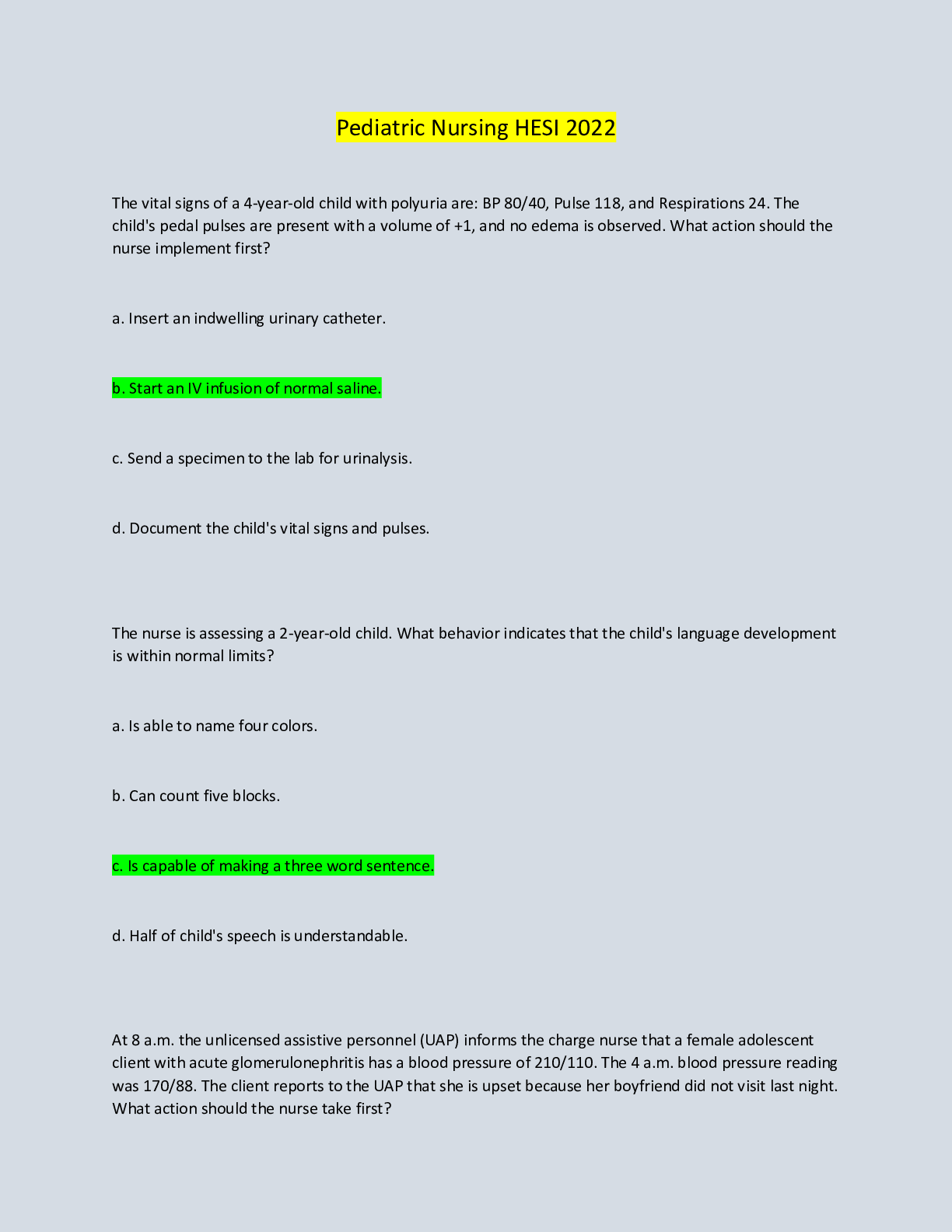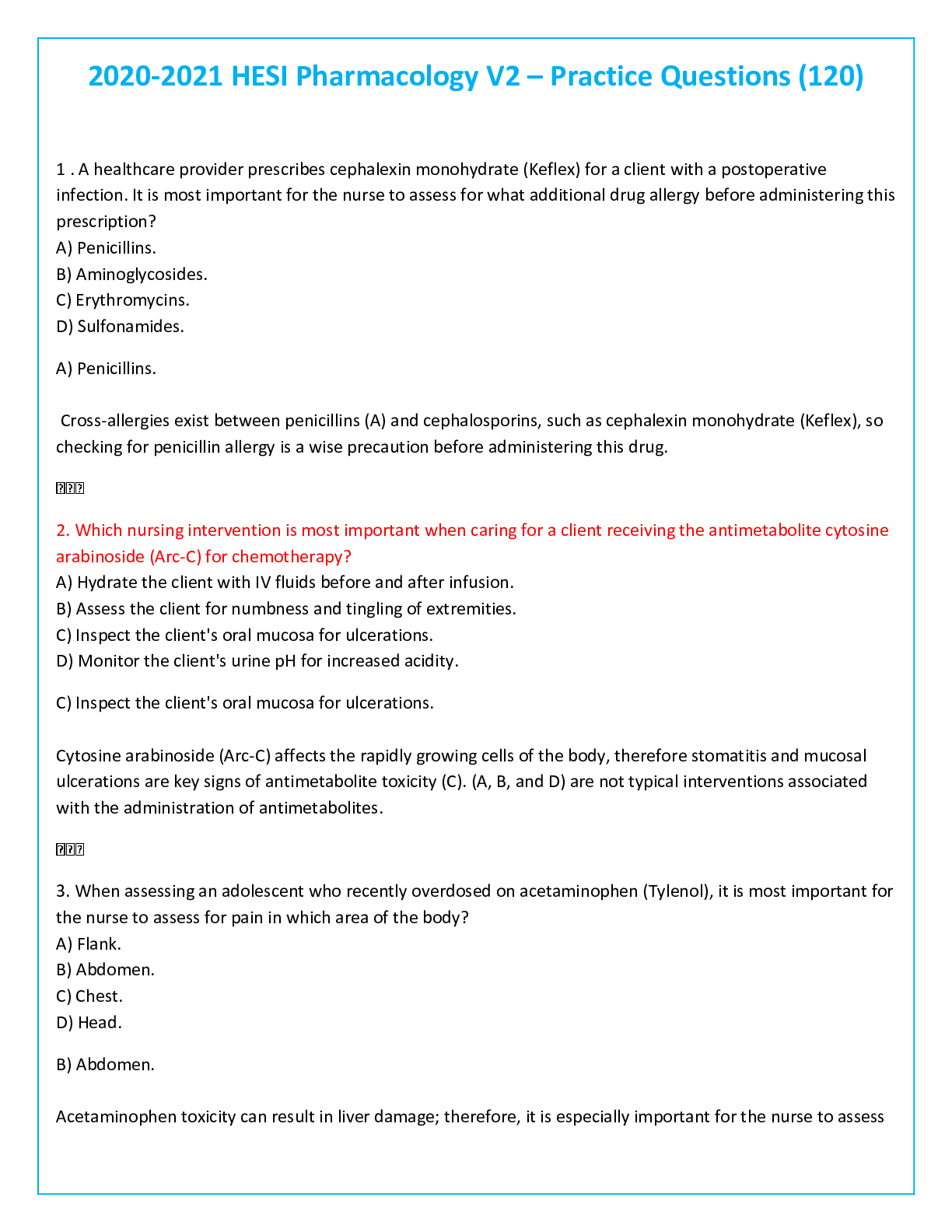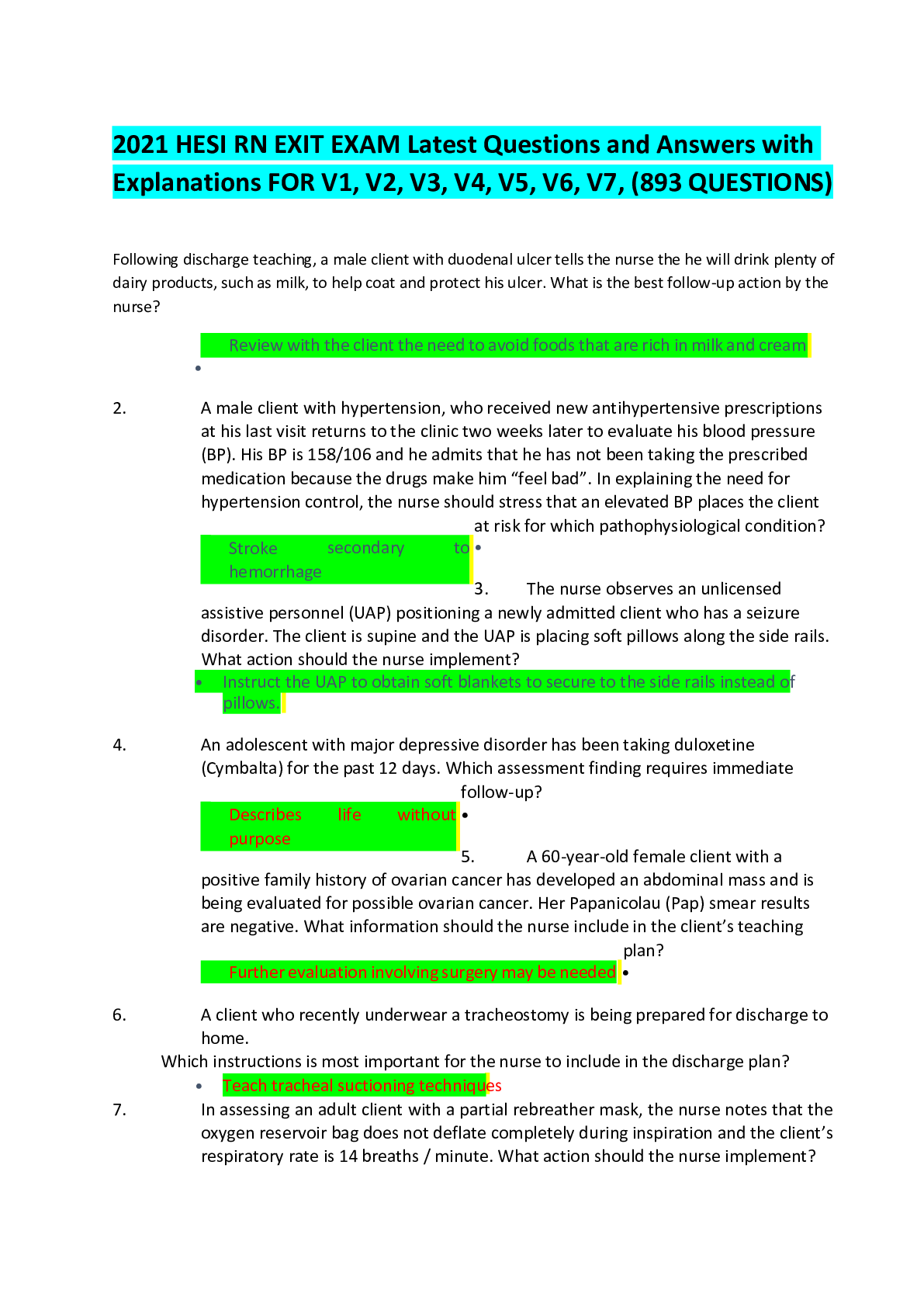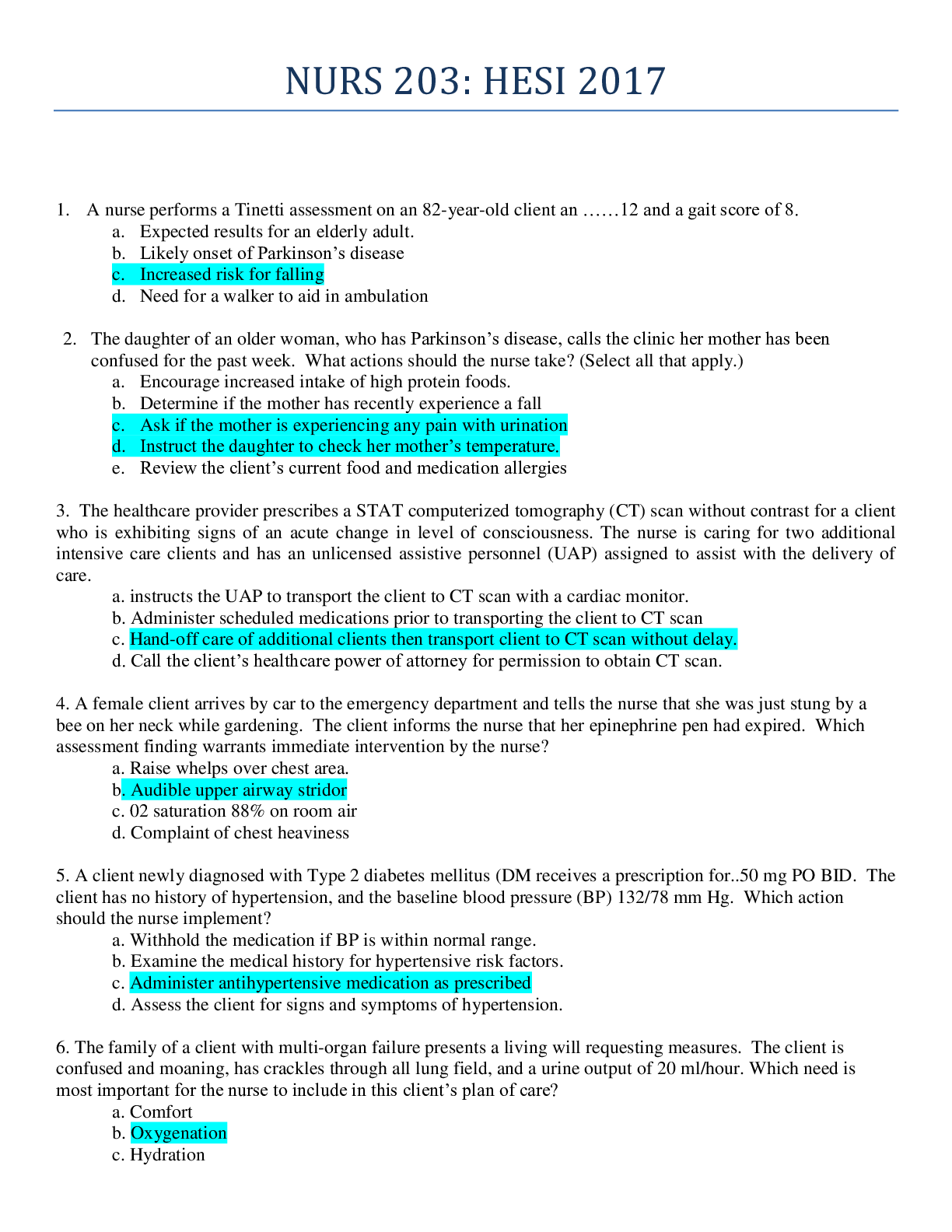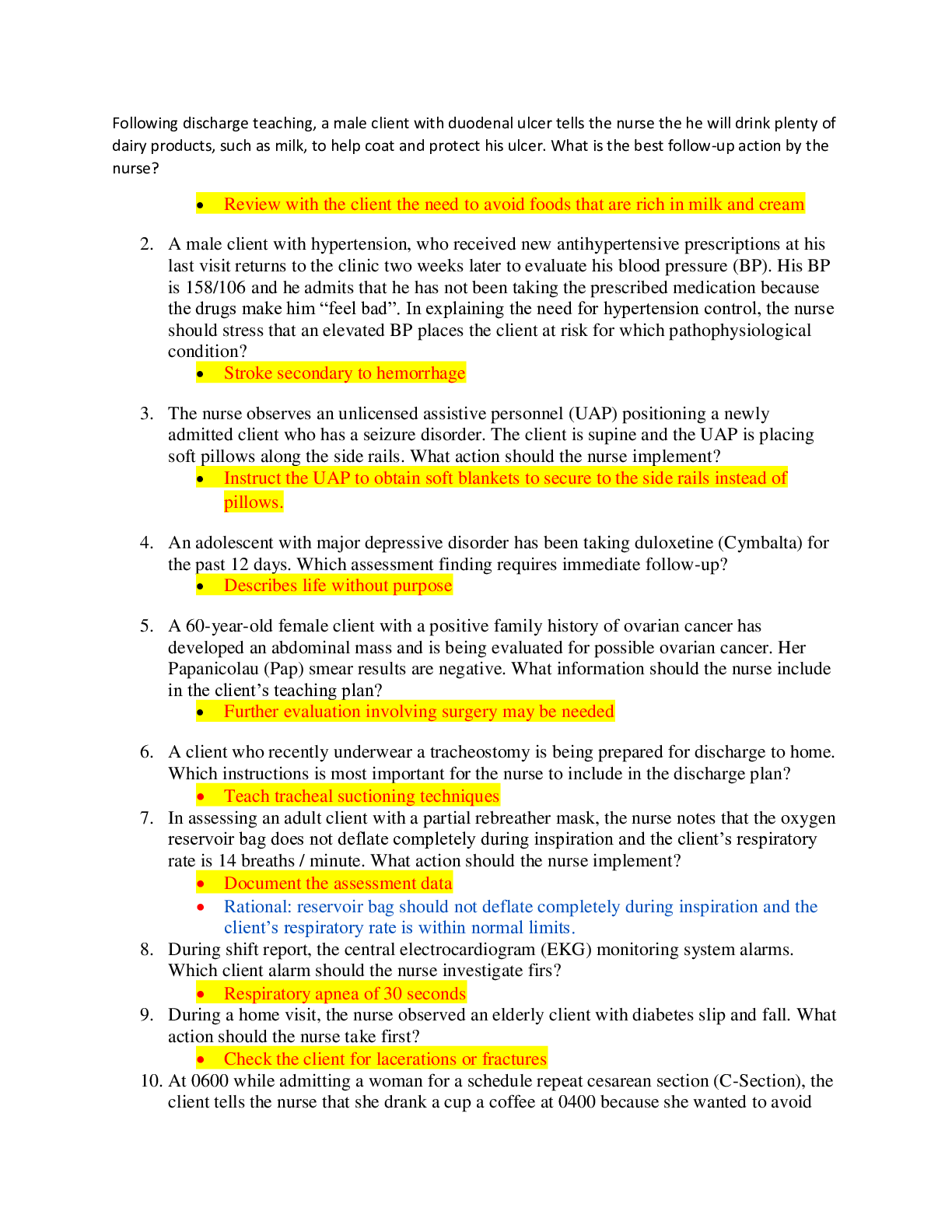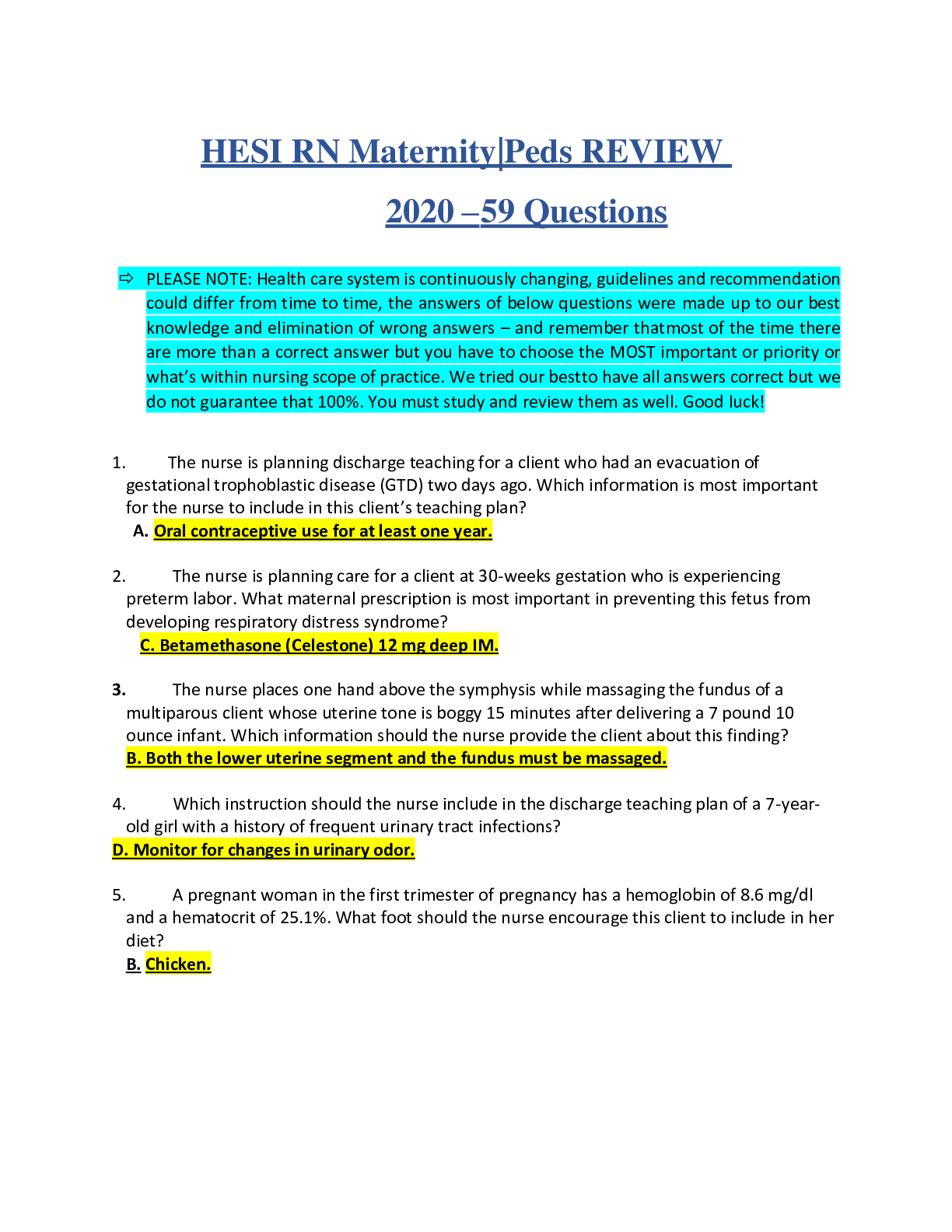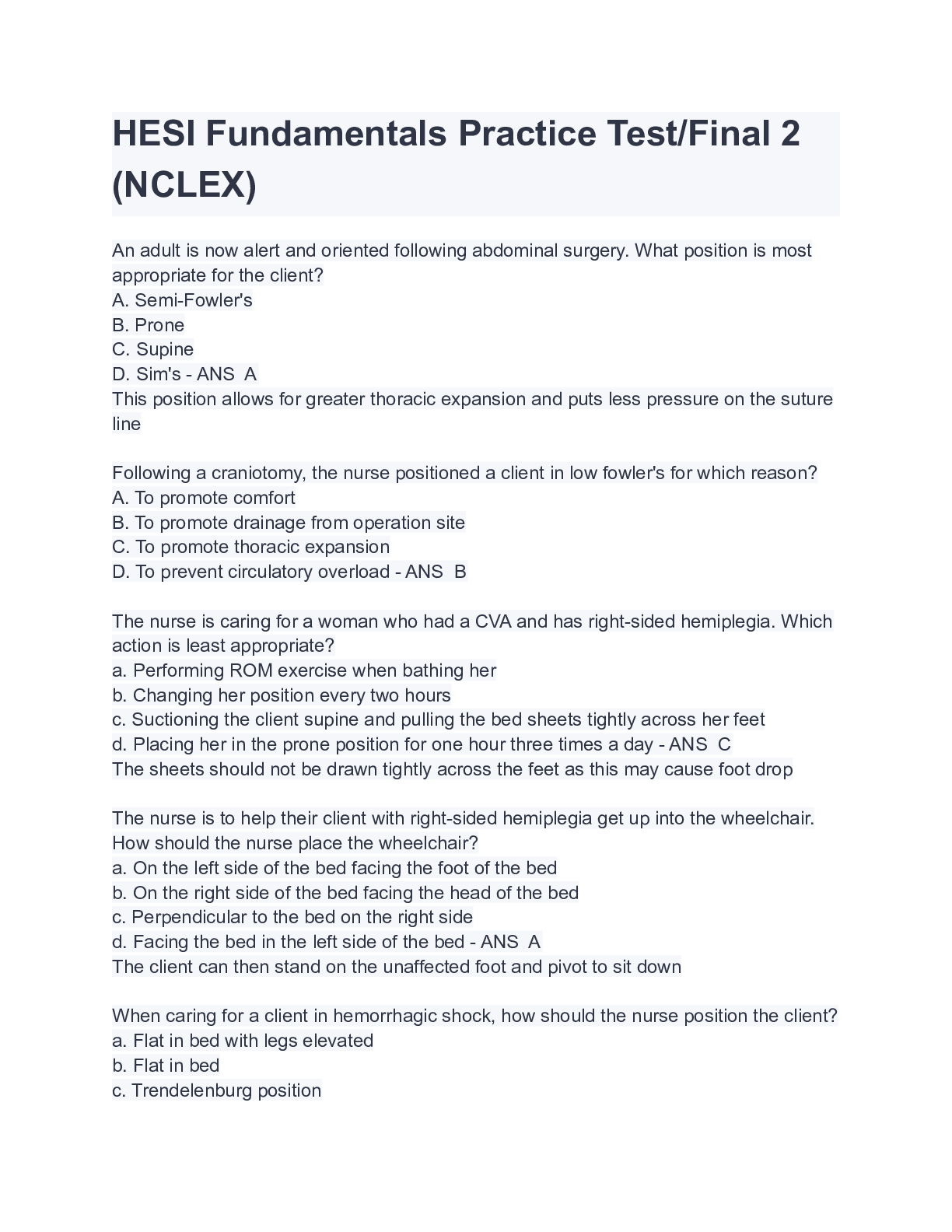*NURSING > HESI > HESI RN Practice Test - Fundamentals Practice Test/Final 2nd Version (NCLEX) Ace your score by study (All)
HESI RN Practice Test - Fundamentals Practice Test/Final 2nd Version (NCLEX) Ace your score by studying this resource
Document Content and Description Below
HESI RN Practice Test - Fundamentals Practice Test/Final 2nd Version (NCLEX) An adult who is receiving heparin asks the nurse why it cannot be given by mouth. The nurse responds that heparin is giv... en parenterally because a. it is destroyed by gastric secretions b. It irritates the gastric mucosa c. It irritates the intestinal lining d. Therapeutic levels can be attained more therapeutically The nurse is to help their client with right-sided hemiplegia get up into the wheelchair. How should the nurse place the wheelchair? a. On the left side of the bed facing the foot of the bed b. On the right side of the bed facing the head of the bed c. Perpendicular to the bed on the right side d. Facing the bed in the left side of the bed When caring for a client in hemorrhagic shock, how should the nurse position the client? a. Flat in bed with legs elevated b. Flat in bed c. Trendelenburg position d. Semi-Fowler's position Mr. Landon is to have a tracheostomy performed. What is the top nursing priority? a. Shave the neck b. Establish a means of communication c. Insert a Foley catheter d. Start an IV Mr. Landon is to have a tracheostomy performed. Which nursing action is essential during tracheal suctioning? a. Using a lubricant such as petroleum jelly b. Administering 100% oxygen before and after suctioning c. Making sure that the suction catheter is open or on during insertion d. Assisting the client to assume a supine position during suctioning Mr. Landon is to have a tracheostomy performed. Which of the following actions is most appropriate for the nurse to take when suctioning the tracheostomy? a. Use sterile tube each time and suction for 30 seconds b. Use sterile technique and turn the suction off as the catheter is introduced c. Use clean technique and suction for 10 seconds d. Discard the catheter at the end of every shift Mr. Landon is to have a tracheostomy performed. While the nurse is suctioning a tracheostomy tube, the client starts to cough. What is the best action for the nurse to take? a. Suction deeper to pick up secretions b. Gently withdraw suction tubing to allow suction or coughing out of mucous c. Remove the suction as quickly as possible d. Put the suction in and out several times to pick up secretions During the suctioning of a tracheostomy tube, the catheter appears to attach to the tracheal walls and creates a pulling sensation. What is the best action for the nurse to take? a. Release the suction by opening the vent b. Continue suctioning to remove obstruction c. Increase the pressure d. Suction deeper Warm compresses are ordered for an open wound. Which action is appropriate for the nurse? a. Use sterile technique when applying the dressing b. Leave the compresses on the area continuously, pouring warm solution on the area when it cools down c. Alternate warm compressed with cold ones d. Apply wet dressing, cover with dry dressing The day after surgery in which a colostomy was performed, the client says "I know the doctor did not really do a colostomy". The nurse understands that the client is in an early stage of adjustment to the diagnosis or surgery, with nursing action is indicated at this time? a. Agree with the client until he is ready to accept the colostomy b. Say "It must be difficult to have this kind of surgery" c. Force the client to look at his colostomy d. Ask the surgeon to explain the surgery to the client The nurse is preparing to insert an indwelling catheter. What type of technique should the nurse observe to perform this procedure? a. Clean technique b. Medical Asepsis c. Isolation Protocol d. Sterile Technique . The nurse is performing a urethral catheterization on a female. After separating the labia, where would the nurse observe the urethral meatus? a. Between the vaginal orifice and the anus b. Between the clitoris and the vaginal orifice c. Just above the clitoris d. Within the vaginal canal The nurse is attempting to pass an indwelling catheter in an adult male and is having difficulty. What is the most appropriate action for the nurse? a. Remove the catheter and reinsert it with the client positioned differently b. Try a straight catheter instead c. Try a smaller catheter d. Discontinue the procedure and notify the physician D-- This may indicate an obstruction After insertion of the indwelling catheter, how should the nurse position the drainage container? a. With the drainage tubing taut to maintain maximum suction on the urinary bladder. b. Lower than the bladder to maintain a constant downward flow of urine from the bladder. c. At the head of the bed for easy and accurate measurement of urine. d. Beside the patient in his bed to avoid embarrassment. An adult had an indwelling catheter removed, after she voids for the first time, the nurse catheterizes her as ordered and obtained 200 cc of urine. What is the best interpretation of this finding? The client: a. Is voiding normally b. Has urinary retention c. Has developed renal failure d. Needs an indwelling catheter The nurse plans to foster a therapeutic relationship with the patient utilizing therapeutic techniques of communication. It is most important that the nurse: a. Work on establishing a friendship with the patient b. Use humour to diffuse emotionally charged topics of discussion c. Sympathize with the patient when the patient shares sad feelings d. Demonstrate respect when discussing emotionally charged topics The main purpose of the working phase of the nurse-patient relationship is to: a. Establish a formal or informal contract that adheres to the patient's problems. b. Implement nursing interventions that are designed to achieve expected patient outcome. c. Develop rapport and trust so the patient feels protected and initial plan can be identified. d. Clearly identify the role of the nurse and establish the parameters of the professional relationship. A patient says, "I don't know if I'll make it through this surgery", which response by the nurse may block further communication? a. "You sound scared" b. "You think you will die." c. "Surgery can be frightening" d. "Everything will be alright" A patient, who is to receive nothing by mouth (NPO) in preparation for bronchoscopy says "I'm worried about the test and I can't even have a drink of water." What is the best response by the nurse? a. "Lets talk about your concerns regarding the test". b. "I'll see if the doctor will let you have some ice chips". c. "The doctor will review the results of the test as soon as possible". d. "As soon as the test is over, I'll get you whatever you would like to drink". Which are components of a complete health history? Select all that apply. a. Chief complain b. History of the present illness c. Past medical/surgical history d. Family, personal, and social history e. Review of systems f. Physical exam Following amputation of a lower extremity, a patient with prosthesis, should be educated by the nurse to a. Wear the prosthesis daily, but remove immediately when discomfort is experienced b. Adjust the fit of the prosthesis by wearing a heavier sock to insure a tight fit c. To put the prosthesis on immediately upon rising in the morning and keep it on all day d. To apply oil or lotion to the stump before applying prosthesis When preparing a client for a blood transfusion, the nurse should consider for which of the following? (Select all that apply) a. Blood typing and cross-matching must be completed prior to a blood transfusion b. Clients with type A should only receive Type A blood but may receive type O in an emergency c. clients with type B blood should only receive type B blood, but may receive type A in an emergency d. Clients with type AB blood are "universal recipients" and should only receive type AB blood but may, in an emergency receive all four types of blood During a skin assessment, a client asks a question about what the skin does. The nurse's response would be based on the knowledge that the functions of the skin include (Select all that apply.) a. Temperature regulation b. Sensory perception c. Identification d. Protection Which of the following is an ABNORMAL finding when observing Water Sealed Chest Drainage for proper functioning? a. Bubbling initially with coughing and deep inspiration b. Continuous bubbling where the water seal is maintained c. Water level fluctuations with breathing d. A collection chamber that is less than 1/2 full Hyperolality Symptom of dementia associated with the 3rd stage of Alzheimer's disease An elderly patient has been living in a nursing home for several years. The nursing staff has begun to notice a change in her behavior. All of the following are symptoms of depression except: a. Changes in sleep patterns b. Changes in eating patterns with weight loss c. Excessive fatigue and increased concern with bodily functions d. Hyperorality The census on the unit is 90 percent and there are no private rooms available. An elderly client with influenza is admitted. Which of the following rooms would it be appropriate to assign this client? a. A double room with a client admitted for impetigo. b. A double room with another client with the same diagnosis. c. A four-bed room with three clients who have had orthopedic surgery. d. A double room with an elderly client with a diagnosis of chickenpox. You are assigned to teach a nursing student how to suction an adult patient with a tracheostomy. Which of the following actions by the nursing student would be INCORRECT? a. Pre-oxygenation of the patient with a Resusibag at 100% 02 several times before suctioning b. Maintains wall suction pressure at 110-150mmHG c. Does not suction for greater than 10-15 seconds at a time d. Applies gentle intermittent pressure and rotates catheter during insertion phase of suctioning When a client has suffered severe burns all over his body, the most effective method of monitoring the cardiovascular system is a. Cuff blood pressure. b. Arterial pressure. c. Pulmonary artery pressure. d. Central venous pressure. When is the first dose of Hep B given? In the hospital at birth An adult has just died. How should the nurse prepare the body for transfer to the mortuary? a. Leave the body as is, no prep needed b. Bathe the body and put ID tags on it c. Remove dentures before bathing body d. Position the body with its head down and arms folded on its chest. A patient has decreased cardiac output following a surgery. What will the nurse likely see in this patient? a. Decreased urine output b. Increased urine output c. Flushing of the skin d. Hyperventilation The nurse counts an adult's apical heart beat at 110 beats per min. The nurse describes this as a. asystole b. bigeminy c. tachycardia d. bradycardia A client as an elevated AST 24 hours following chest pain and shortness of breath. This is suggestive of which of the following? a. Gallbladder disease b. Liver disease c. Myocardial infarction d. Skeletal muscle injury AST is an enzyme released in response to tissue damage. AST rises 24 hours after an MI. It will also rise with liver and skeletal muscle injuries An adult has a coagulation time of 20 minutes. The nurse should observe the client for which of the following? a. blood clots b. Ecchymotic areas c. jaundice d. infection A prothrombin time test should be performed regularly on persons who are taking which medication? a. Heparin b. Warfarin c. Phenobarbital d. Digoxin Which prothrombin time value would be considered normal for a client who is receiving warfarin? a. 12 seconds b. 20 seconds c. 60 seconds d. 90 seconds The nurse is caring for a client who is receiving heparin. What drug should be readily available? a. Vitamin K b. Caffeine c. Calcium gluconate d. Protamine sulfate Vit K is antidote for Coumadin During the admission interview, a client who is admitted for a cardiac catheterization says, "Every time I eat shrimp I get a rash". What action is essential for the nurse to take at this time? a. Notify the physician b. Ask the client if they get a rash from any other foods c. Instruct the dietary department not to give the client shrimp d. Teach the client the dangers of eating shrimp and other shellfish When a client returns from undergoing a cardiac cath, it is most essential for the nurse to a. Check peripheral pulses b. Maintain NPO c. Apply heat to the insertion site d. Start range of motion exercises immediately A client with asbestosis must see his doctor regularly for a check up. What is the primary reason for him to have frequent checkups? A. Patients with asbestosis are at high risk for developing bronchogenic cancer. B. His doctor is monitoring him closely to look for signs of improvement. C. Patients who use low flow oxygen for long periods are at high risk for developing neurological symptoms. D. Periodic sputum samples are needed to follow the progress of the disease. An order is written for oxygen by nasal cannula at 2 liters per minute. In assessing the adequacy of the oxygen therapy, which of the following is most effective? A. Checking the respiratory rate. B. Checking the color of mucous membranes. C. Measurement of pulmonary functions. D. Measurement of arterial blood gasses A patient is admitted with histoplasmosis. Which item in the patient's history is most likely related to the onset of the disease? A. He works in a factory. B. He likes to explore caves. C. He has three cats. D. He smokes four packs of cigarettes a week. The nurse in a medical unit is caring for a client with heart failure. The client suddenly develops extreme dyspnea, tachycardia, and lung crackles, and the nurse suspects pulmonary edema. The nurse immediately notifies the registered nurse and expects which interventions to be prescribed? Select all that apply. Administering oxygen Administering Digoxin Inserting a Foley catheter Administering furomeside (Lasix) Administering morphine sulfate intravenously The nurse is caring for a client with left-sided heart failure. Which clinical signs are most important for the nurse to communicate to the health care provider? Select all that apply. Pink-tinged frothy sputum Decrease in respiratory rate Increase in respiratory rate Yellow tinged sputum Auscultation of crackles throughout the lungs The nurse is caring for a client who is developing pulmonary edema. The client exhibits respiratory distress, but the blood pressure is unchanged from the client's baseline. As an immediate action before help arrives, the nurse should perform which action? A. Place the client in high-Fowler's position B. Lie the client flat C. Place client in prone position D. Place client in Semi-Fowler's A client has just returned from the cardiac catheterization laboratory. The left femoral vessel was used as the access site. After returning the client to bed, the nurse places a sign above the bed stating that the client should remain on bed rest and in which position? A. With the head of the bed elevated no more than 15 degrees B. At a 30-45 Degree angle C. Lying flat D. High-Fowler's A client with myocardial infarction suddenly becomes tachycardic, shows signs of air hunger, and begins coughing frothy, pink-tinged sputum. The nurse listens to breath sounds, expecting to hear which breath sounds bilaterally? A. Wheezes B. Scratching C. Crackles D. Air Blood flows to the ______ atrium from the superior and inferior vena cavae right Blood flows from the right atrium to the right ventricle via the_______ valve tricuspid Blood flows from the right ventricle to the lungs for ____________________ oxygenation Blood flows from the _____ to the left atrium lungs Blood flows from the left atrium via the ______ valve to the left ventricle mitral Blood flows from the ____ ventricle to the aorta and then to the systemic circulation left The nurse is caring for a client who has had a recent myocardial infarction involving the left ventricle. Which assessment finding is expected? a. Faint S1 and S2 sounds b. Decreased cardiac output c. Increased blood pressure d. Absent peripheral pulses B The myocardium is the layer responsible for the contractile force of the heart. Damage to this layer can result in decreased cardiac output. This most likely would result in decreased blood pressure and strength of peripheral pulses. Absent peripheral pulses would be caused by an arterial occlusion. S1 and S2 most likely would not be affected. The nurse is assessing a client following a myocardial infarction. The client is hypotensive. What additional assessment finding does the nurse expect? a. Heart rate of 120 beats/min b. Cool, clammy skin c. Oxygen saturation of 90% d. Respiratory rate of 8 breaths/min The nurse is caring for a client with coronary artery disease. What assessment finding does the nurse expect if the client's mean arterial blood pressure decreases below 60 mm Hg? a. Increased cardiac output b. Hypertension c. Chest pain d. Decreased heart rate The nurse administers a beta blocker to a client after a myocardial infarction. What assessment finding does the nurse expect? a. Blood pressure increase of 10% b. Increasing respiratory rate c. Increased cardiac output d. Pulse decrease from 100 to 80 beats/min The nurse is assessing clients at a community health center. Which client does the nurse determine is at high risk for cardiovascular disease? a. Older adult man with a history of asthma b. Asian-American man with colorectal cancer c. American Indian woman with diabetes mellitus d. Postmenopausal woman on hormone therapy A nurse is performing an admission assessment on an older adult client with multiple chronic diseases. The nurse assesses the heart rate to be 48 beats/min. What does the nurse do first? a. Document the finding in the chart. b. Evaluate for a pulse deficit. c. Assess the client's medications. d. Administer 1 mg of atropine. An adult is now alert and oriented following abdominal surgery. What position is most appropriate for the client? A. Semi-Fowler's B. Prone C. Supine D. Sim's Following a craniotomy, the nurse positioned a client in low fowler's for which reason? A. To promote comfort B. To promote drainage from operation site C. To promote thoracic expansion D. To prevent circulatory overload The nurse is caring for a woman who had a CVA and has right-sided hemiplegia. Which action is least appropriate? a. Performing ROM exercise when bathing her b. Changing her position every two hours c. Suctioning the client supine and pulling the bed sheets tightly across her feet d. Placing her in the prone position for one hour three times a day [Show More]
Last updated: 2 years ago
Preview 1 out of 14 pages
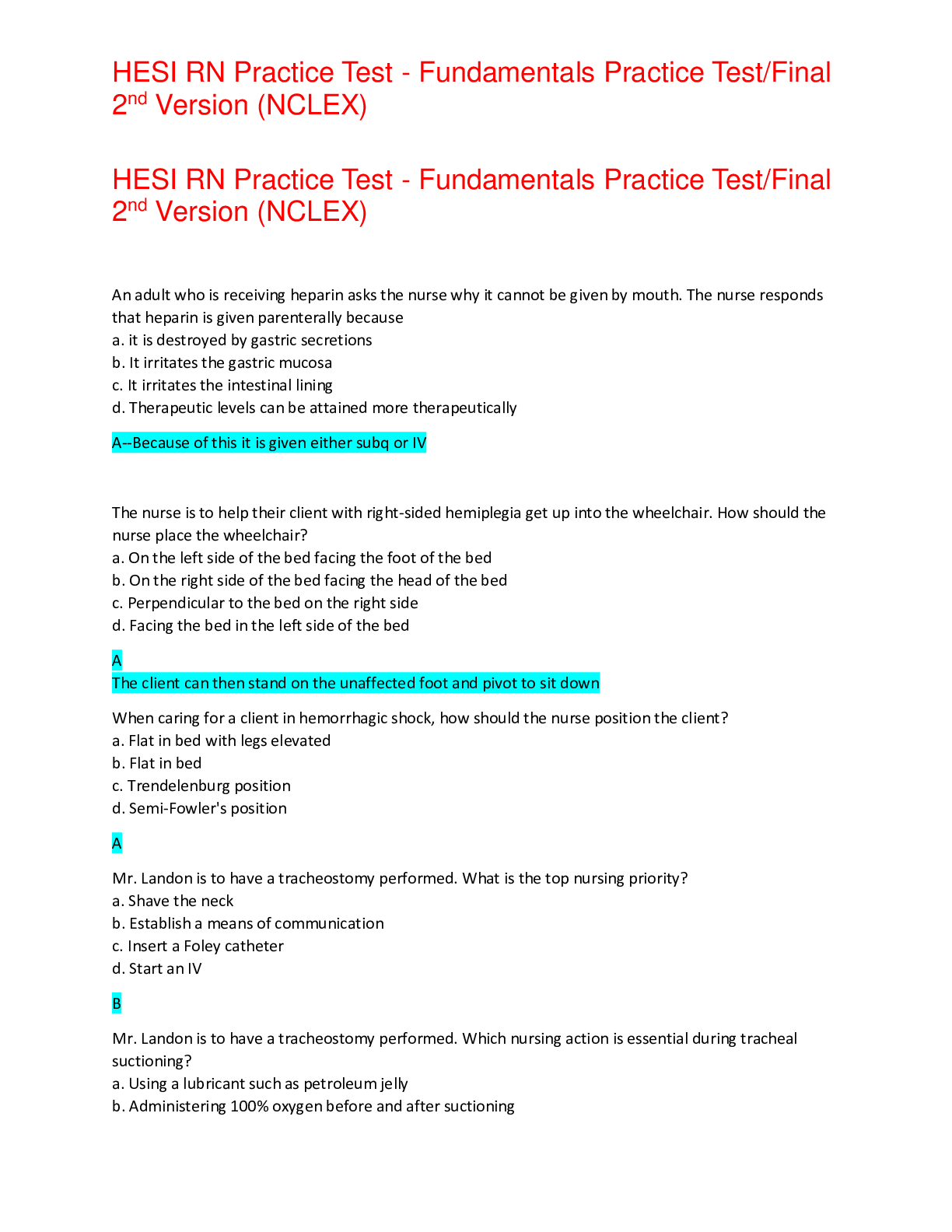
Buy this document to get the full access instantly
Instant Download Access after purchase
Buy NowInstant download
We Accept:

Reviews( 0 )
$16.00
Can't find what you want? Try our AI powered Search
Document information
Connected school, study & course
About the document
Uploaded On
Oct 14, 2021
Number of pages
14
Written in
Additional information
This document has been written for:
Uploaded
Oct 14, 2021
Downloads
0
Views
222

